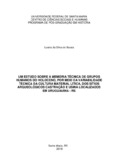| dc.creator | Souza, Luana da Silva de | |
| dc.date.accessioned | 2019-03-13T12:20:23Z | |
| dc.date.available | 2019-03-13T12:20:23Z | |
| dc.date.issued | 2018-09-18 | |
| dc.identifier.uri | http://repositorio.ufsm.br/handle/1/15891 | |
| dc.description.abstract | The present study is part of the work under development in the Memory and Heritage research field, which is linked to the project "Guarda – Rain: Material Culture and Historical and Pre - Historical Societies of the Platinum Basin: research and socialization of knowledge", coordinated by Professor Dr André Luis Ramos Soares, as part of the Post-Graduate Program in History of the Federal University of Santa Maria (PPGH-UFSM), as well as the Post-Graduate Program in Prehistoric Archeology and Rock Art of the Polytechnic Institute of Tomar - Portugal , considering the International Cooperation Agreement established between the Tomar Institute (IPT) and the Federal University of Santa Maria (UFSM), and receives financial support through the CAPES / DS grant. This research consists of the technological analysis of the lithic collection of the Castração and Usina Archaeological Site located in the region of Uruguaiana, southwest of Rio Grande do Sul. The analysis of the lytic material was carried out realized the technological methodology of the French school, seeking to contribute to a greater understanding of the experience of past hunter-gatherer populations and their technical memory. In order to achieve these objectives, the present work has the purpose to identify and understand the operative chain of the lytic collection and its stages, based on a methodology that prioritizes the analysis - from the choices and acquisition of raw material, till the abandonment of object. | eng |
| dc.description.sponsorship | Coordenação de Aperfeiçoamento de Pessoal de Nível Superior - CAPES | por |
| dc.language | por | por |
| dc.publisher | Universidade Federal de Santa Maria | por |
| dc.rights | Attribution-NonCommercial-NoDerivatives 4.0 International | * |
| dc.rights.uri | http://creativecommons.org/licenses/by-nc-nd/4.0/ | * |
| dc.subject | Caçadores-coletores | por |
| dc.subject | Cultura material | por |
| dc.subject | Memória técnica | por |
| dc.subject | Uruguaiana | por |
| dc.subject | Hunter-collectors | eng |
| dc.subject | Material culture | eng |
| dc.subject | Technical memory | eng |
| dc.title | Um estudo sobre a memória técnica de grupos humanos do holoceno, por meio da variabilidade técnica da cultura material lítica, dos sítios arqueológicos castração e usina localizados em Uruguaiana - RS | por |
| dc.title.alternative | A study of the technical memory of human groups of the holocene, through the technical variability of the lithic material culture of the archaeological sites castração and usina located in Uruguaiana – RS | eng |
| dc.type | Dissertação | por |
| dc.description.resumo | O presente estudo, é integrado aos trabalhos em desenvolvimento na linha de pesquisa Memória e Patrimônio, vinculado ao projeto “Guarda – Chuva: Cultura Material e sociedades Históricas e Pré-Históricas da Bacia Platina: pesquisa e socialização do conhecimento”, coordenado pelo professor Dr. André Luis Ramos Soares, dentro do programa de Pós-Graduação em História da Universidade Federal de Santa Maria (PPGH-UFSM), assim como do programa de Pós-Graduação de Arqueologia Pré-Histórica e Arte Rupestre do Instituto Politécnico de Tomar – Portugal, considerando o Acordo de Cooperação Internacional estabelecido entre o Instituto Tomar (IPT) e a Universidade Federal de Santa Maria (UFSM) e recebe apoio financeiro através de bolsa CAPES/DS. Esta pesquisa consiste na análise tecnológica da coleção lítica do Sitio Arqueológico Castração e Usina, localizados na região de Uruguaiana, sudoeste do Rio Grande do Sul. A análise do material lítico foi realizada com a utilização da metodologia tecnológica da escola francesa, buscando contribuir para uma maior compreensão da vivência de populações pretéritas de caçadores-coletores e de sua memória técnica. A fim de atingir estes objetivos, neste trabalho foi realizada a identificação e compreensão da cadeia operatória da coleção lítica e suas etapas, a partir de uma metodologia que prioriza a análise – desde as escolhas e aquisição de matéria prima, até o abandono do objeto. | por |
| dc.contributor.advisor1 | Soares, Andre Luis Ramos | |
| dc.contributor.advisor1Lattes | http://lattes.cnpq.br/4984779171371127 | por |
| dc.contributor.advisor-co1 | Oosterbeek, Luiz Miguel | |
| dc.contributor.advisor-co1Lattes | http://lattes.cnpq.br/6023731371573833 | por |
| dc.contributor.referee1 | Hilbert, Klaus Peter Kristian | |
| dc.contributor.referee1Lattes | http://lattes.cnpq.br/0704678157445792 | por |
| dc.contributor.referee2 | Remedi, José Martinho Rodrigues | |
| dc.contributor.referee2Lattes | http://lattes.cnpq.br/4112671771507306 | por |
| dc.creator.Lattes | http://lattes.cnpq.br/1229033348546565 | por |
| dc.publisher.country | Brasil | por |
| dc.publisher.department | História | por |
| dc.publisher.initials | UFSM | por |
| dc.publisher.program | Programa de Pós-Graduação em História | por |
| dc.subject.cnpq | CNPQ::CIENCIAS HUMANAS::HISTORIA | por |
| dc.publisher.unidade | Centro de Ciências Sociais e Humanas | por |



